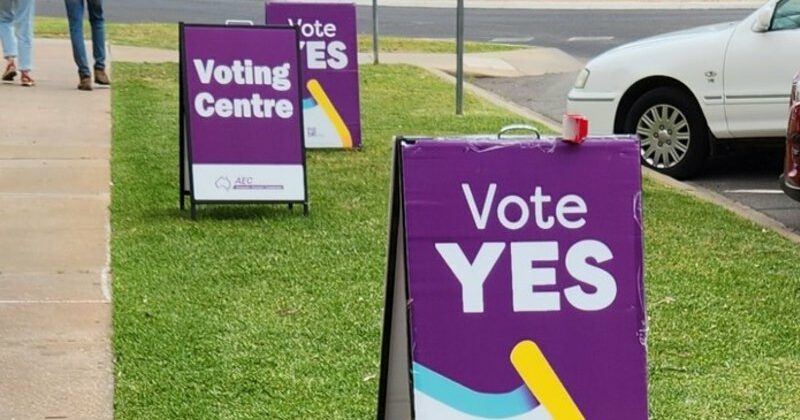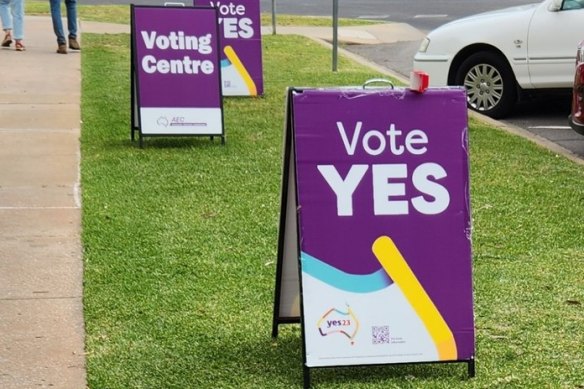Save articles for later
Add articles to your saved list and come back to them any time.
The Australian Electoral Commission has warned the Yes23 Voice campaign that some of its signs could be potentially misleading and demanded it move them away from polling stations.
Some Yes23 signs – which say “Vote YES” – use the same purple colour as the commission’s signs, which have the words “voting centre” on them and are used to inform voters about polling booth locations for the Voice referendum.
Yes23 campaign signs alongside official AEC signs in the regional Victorian town of Mildura.
The commission said in a statement late on Monday, the first day of early voting, that it had become aware of signs that could “potentially mislead voters”, who might see the official purple colours and become confused about whether a Yes vote was perhaps mandatory, or encouraged, by authorities.
“To be absolutely clear – the signs were erected by the Yes23 campaign, not the AEC,” the statement said.
“When we were alerted to this signage, the AEC requested the Yes23 campaign to rectify the situation by ensuring their signs are not placed in the proximity of AEC voting centre signs.
“The Yes23 campaign has agreed to comply with this request.”
The AEC noted Yes23’s sign had been authorised appropriately – as it was marked as a Yes23 sign in the bottom corner – and was therefore not illegal.
In a statement, a spokesperson for the Yes campaign said: “Yes23 was made aware of this by the AEC and will rectify the situation.”
A shade of purple similar to the AEC’s trademark colour has featured prominently in Yes23 material for months, including on its website and in other places at which it would be of no benefit for Yes23 to replicate AEC colours.
Yes23 headquarters has told its volunteers not to place the signs near the commission’s, after a photo of the signs in the regional Victorian town of Mildura on Monday drew scrutiny and spurred right-wing figures to accuse Yes of deceptive tactics.
A spokesman for Fair Australia, the leading No campaign outfit, claimed the Yes campaign had rolled the signs out across NSW.
“We have gone to great lengths to comply with the election umpire’s often unreasonable requests, which have been consistently ignored by Yes23. For example, Yes23 is still running unauthorised digital ads,” the spokesman said.
“Australians will not be tricked into voting for the divisive Voice.”
Opposition Leader Peter Dutton said on Tuesday that the signs were clearly in breach of the rules, while Prime Minister Anthony Albanese said he was sure the Yes campaign would comply with any directions from the electoral commission.
One Nation leader Pauline Hanson posted on social media: “The Yes campaign has been caught red-handed using signs the exact same colour as the AEC, trying to mislead Aussie voters. [Albanese] talks a lot about ‘misinformation’. Will he demand the Yes campaign stop using these confusing and deceptive signs?”
Anti-lockdown activist and right-wing citizen journalist Rukshan Fernando gained hundreds of thousands of views for posts on X, formerly Twitter, claiming the electoral commission “didn’t appear particularly interested” in the Yes signs, despite it having asked for them to be removed.
In 2019, the Victorian Liberal Party faced scrutiny for signs containing Liberal messaging in Chinese language using colours similar to the commission’s.
The boss of the Victorian Liberal division at the time was Simon Frost, who is now Yes23’s campaign operations director.
Labor campaigner turned pollster Kos Samaras referred to Frost on Tuesday, posting a picture of the Liberal with the caption: “Look. It was done before.”
This masthead is not suggesting Frost played any role in choosing Yes23’s colour schemes, which were picked before he joined the referendum campaign in May.
Cut through the noise of federal politics with news, views and expert analysis. Subscribers can sign up to our weekly Inside Politics newsletter.
Most Viewed in Politics
From our partners
Source: Read Full Article

